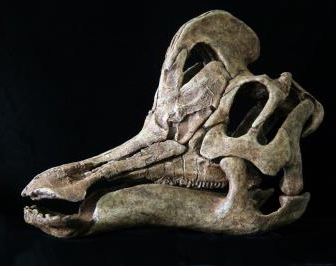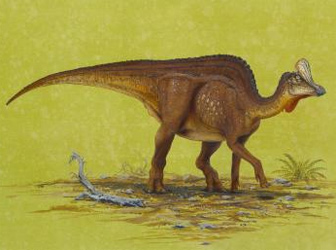New duck-billed dinosaur discovered in Mexico
New duck-billed dinosaur discovered in Mexico
mongabay.com
February 12, 2008
|
|
A previously unknown species of dinosaur has been discovered in Mexico, shadding new light on the history of western North America, report researchers from the Utah Museum of Natural History at the University of Utah.
The 72-million-year-old ago beast, a type of duck-billed dinosaur or hadrosaur, has been named Velafrons coahuilensis. The genus “Velafrons” refers to the dinosaur’s large sail-like crest, while the species name “coahuilensis” is a reference to the state where the speciment was found.
The plant-eating dinosaur was found in an area that was formerly an estuary near the southernmost tip of West America, a narrow, peninsula-like western landmass of North America formed when North America was split in two by a warm, shallow sea.
 Reconstructed skull of Velafrons coahuilensis, a 72-million-year-old duck-billed specimen discovered in Coahuila, Mexico. Credit: Reconstruction courtesy of Gaston Design, Inc.
|
Terry Gates, a paleontologist with the Utah Museum of Natural History, said the duck-billed dinosaur appeared to have inhabited a region where mass deaths due to storms were not unusual.
“The region was periodically hammered by monstrous storms,” Sampson said, “devastating miles of fertile coastline, apparently killing off entire herds of dinosaurs.”
The researchers believe the species may have attained a length of 30 feet to 35 feet as an adult. It is the first crested duck-billed dinosaur found in western North America.
The researchers also found remains of a second type of duck-bill dinosaur; a plant-eating horned dinosaur similar to Triceratops; and several carnivores, including large tyrannosaurs and more diminutive Velociraptor-like predators armed with sickle-claws on their feet. Some of the discoveries may turn out to be previously unknown species.
“I am amazed at how prolific this region is,” said Gates. “Given the large number of fossils, the high quality preservation, and the great research team that is working this area, more spectacular discoveries are just around the corner.”
“Dinosaurs from this particular period are important because this is a time that is relatively poorly understood,” said Don Brinkman, a project researcher from Canada’s Royal Tyrrell Museum of Paleontology. “The locality in Mexico goes a long way to filling in a gap in our knowledge of the record of changes in dinosaur assemblages throughout the Late Cretaceous era.”
“Now that we’ve cracked open this amazing window into the world of dinosaurs, we look forward to future expeditions that will undoubtedly reveal more of Mexico’s ancient past,” said Scott Sampson, a Utah Museum of Natural History paleontologist and co-author of the study.
